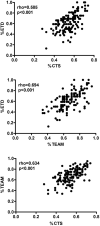Teamwork evaluation during emergency medicine residents' high-fidelity simulation
- PMID: 35516448
- PMCID: PMC8936887
- DOI: 10.1136/bmjstel-2015-000068
Teamwork evaluation during emergency medicine residents' high-fidelity simulation
Abstract
Background: Teamwork training has been included in several emergency medicine (EM) curricula; the aim of this study was to compare different scales' performance in teamwork evaluation during simulation for EM residents.
Methods: In the period October 2013-June 2014, we performed bimonthly high-fidelity simulation sessions, with novice (I-III year, group 1 (G1)) and senior (IV-V year, group 2 (G2)) EM residents; scenarios were designed to simulate management of critical patients. Videos were assessed by three independent raters with the following scales: Emergency Team Dynamics (ETD), Clinical Teamwork Scale (CTS) and Team Emergency Assessment Measure (TEAM). In the period March-June, after each scenario, participants completed the CTS and ETD.
Results: The analysis based on 18 sessions showed good internal consistency and good to fair inter-rater reliability for the three scales (TEAM, CTS, ETD: Cronbach's α 0.954, 0.954, 0.921; Intraclass Correlation Coefficients (ICC), 0.921, 0.917, 0.608). Single CTS items achieved highly significant ICC results, with 12 of the total 13 comparisons achieving ICC results ≥0.70; a similar result was confirmed for 4 of the total 11 TEAM items and 1 of the 8 total ETD items. Spearman's r was 0.585 between ETD and CTS, 0.694 between ETD and TEAM, and 0.634 between TEAM and CTS (scales converted to percentages, all p<0.0001). Participants gave themselves a better evaluation compared with external raters (CTS: 101±9 vs 90±9; ETD: 25±3 vs 20±5, all p<0.0001).
Conclusions: All examined scales demonstrated good internal consistency, with a slightly better inter-rater reliability for CTS compared with the other tools.
Keywords: High-Fidelity Simulation; Self-assessment; Teamwork performance.
Published by the BMJ Publishing Group Limited. For permission to use (where not already granted under a licence) please go to http://www.bmj.com/company/products-services/rights-and-licensing/.
Conflict of interest statement
Competing interests: None declared.
Figures



Similar articles
-
Simulation for Assessment of Milestones in Emergency Medicine Residents.Acad Emerg Med. 2018 Feb;25(2):205-220. doi: 10.1111/acem.13296. Epub 2017 Nov 9. Acad Emerg Med. 2018. PMID: 28833892
-
The PETRA (Perinatal Emergency Team Response Assessment) Scale: A High-Fidelity Simulation Validation Study.J Obstet Gynaecol Can. 2017 Jul;39(7):523-533.e12. doi: 10.1016/j.jogc.2016.12.036. J Obstet Gynaecol Can. 2017. PMID: 28625281
-
Assessing Team Performance in a Longitudinal Neonatal Resuscitation Simulation Training Program: Comparing Validity Evidence to Select the Best Tool.Cureus. 2024 Sep 6;16(9):e68810. doi: 10.7759/cureus.68810. eCollection 2024 Sep. Cureus. 2024. PMID: 39371693 Free PMC article.
-
Conceptualizing Interprofessional Teams as Multi-Team Systems-Implications for Assessment and Training.Teach Learn Med. 2015;27(4):366-9. doi: 10.1080/10401334.2015.1077136. Teach Learn Med. 2015. PMID: 26507993
-
Examining the Effectiveness of Debriefing at the Point of Care in Simulation-Based Operating Room Team Training.In: Henriksen K, Battles JB, Keyes MA, Grady ML, editors. Advances in Patient Safety: New Directions and Alternative Approaches (Vol. 3: Performance and Tools). Rockville (MD): Agency for Healthcare Research and Quality (US); 2008 Aug. In: Henriksen K, Battles JB, Keyes MA, Grady ML, editors. Advances in Patient Safety: New Directions and Alternative Approaches (Vol. 3: Performance and Tools). Rockville (MD): Agency for Healthcare Research and Quality (US); 2008 Aug. PMID: 21249934 Free Books & Documents. Review.
References
LinkOut - more resources
Full Text Sources
Research Materials
